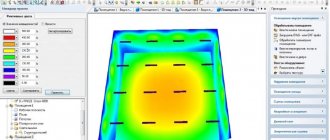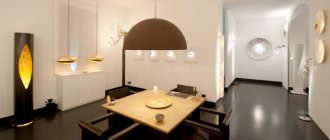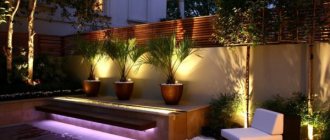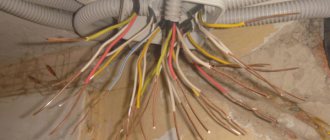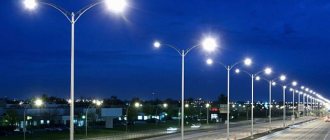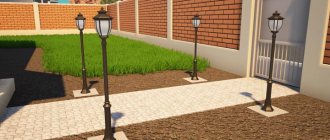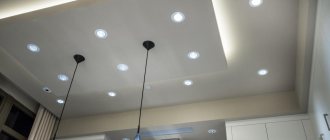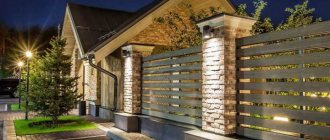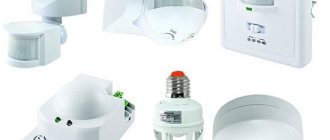Lighting devices for outdoor lighting of local areas and streets perform several important functions, including increasing the safety of residential property.
Well-designed yard systems, aimed at the main objects (gates, wickets, fences), significantly reduce the interest of intruders who will be less willing to think about encroaching on your property. Before calculating street lighting, you need to decide on the location of the lamps, and only then resort to several important physical formulas.
When performing calculations, we strongly recommend taking data from the technical documentation of the installed devices.
Depending on the functional purpose, modern street lighting systems are divided into two types:
- decorating;
- technical.
In the first case, you need to follow a certain sequence, and sometimes a pattern in the distribution of lamps throughout the area. You will need techniques used in landscape design. As for the technical functionality of devices, in this case we are talking about the protective features of the equipment.
Select lighting fixtures in such a way that you feel completely safe when using them and feel comfortable staying on the site. This will reduce the risk of injury from placing your foot incorrectly on the steps of a porch or garden path.
Where to start calculating outdoor street lighting?
Comfort and safety are relative concepts, but they have certain indicators. There is no need to guess what level of illumination will be required for the street. It is enough to refer to the regulatory documents.
According to GOST R 55706-2013, road network objects are divided into classes, each of which requires a certain brightness of artificial light. The indicator is measured in candelas per square meter (cd/m2). Candel is a unit of luminous intensity.
For example:
· Class A (1.2-2.0 cd/m2) includes roads with heavy traffic (highways, federal highways).
· Class B (1-1,2) combines urban and regional routes.
· Class B (0.4-0.8) consists of roads in residential areas in the city center and beyond, as well as industrial areas.
· Class P (0.1-0.3) includes pedestrian streets, alleys, sidewalks, squares in front of public buildings.
You can also find in this GOST information regarding the average illumination of objects, measured in Lux (lx).
Values for the most popular objects:
· The area in front of the entrance to the entertainment building is 20,
· Pedestrian streets and playgrounds – 10,
· Entrance to the park or stadium – 6,
· Sidewalks – 4,
· Central and secondary alleys of parks – 2.
Another document that will help calculate street lighting is SNiP 05/23/95. Here are the values of horizontal illumination (lx) of many urban infrastructure objects:
· Bridges for pedestrians – 10,
· Sports grounds – 10,
· Approaches to various sites – 4,
· Shopping center area – 4.
SNiP 23-05-95 is also useful for calculating the external illumination of facades and shop windows, taking into account the requirements for facade brightness and the degree of reflection depending on the finishing material.
Coordination of lighting networks
Coordination of designed outdoor lighting installations, as a rule, takes much longer than the design itself.
The lighting network must be agreed upon with the organization responsible for lighting the city, with the balance holders of the illuminated areas, and the owners of the networks to which the designed lighting network is connected. The same applies to the owners of underground communications, next to which it is planned to install lighting poles and lay cable lines. First of all, new cable lines are agreed upon with representatives of organizations operating city cable networks. During the approval process, representatives of organizations in charge of underground communications may require that they be provided with sections of the most complex sections of parallel installation and intersections of the designed cable lines with existing communications.
Sometimes it becomes necessary to make adjustments to outdoor lighting projects due to the emergence of new underground communications that did not exist at the time the topographic plans were received.
If excavation work is not provided for the implementation of the lighting network, that is, the lamps are installed on existing supports or attached to cable braces, and the network is carried out with wires and does not contain cables laid in the ground, then the approval of the outdoor lighting project is accordingly simplified.
Outdoor street lighting
Rice. 1 External street lighting
Victor Chernov
July 05, 2015
TO CONTENTS (All articles on the site)
Methods for calculating outdoor lighting
Today in practice there are three methods used for lighting calculations of outdoor lighting :
· Spot – the essence of the method is to calculate indicators for each installed light source. Its advantage is the ability to calculate uneven light. And its main drawback is its labor intensity. This manual method requires special attention and pedantry of the designer.
· With luminous flux coefficient - an even more labor-intensive method that takes into account the reflectivity of objects, the distribution of radiation, and the use of luminous flux. Most often used for interior lighting design.
· The specific power method is the most popular among manual methods due to its simplicity (relative to the previous two options). With its help, you can find the required number of lighting fixtures, based on standard indicators and simple initial data.
Depending on the task at hand, you can use different formulas. Mathematical calculations are needed not only to ultimately comply with lighting standards, but also to use the required number of lighting fixtures. After all, every extra element is not only the cost of its purchase, but also the cost of installation and maintenance.
An example of lighting calculations for external lighting of a children's playground near a house
Let's say you are planning to move to a townhouse, where there is a free 150 square meters for a playground, all that remains is to equip it and install a certain number of lights. But which one?
Let's calculate using the formula:
L = E*S*N*K / (F*X), where
L is the required number of lighting fixtures.
E – illumination (lux). Let’s immediately look at SNiP and take the number 10.
S – area, which by condition is equal to 150 square meters.
N – coefficient of uneven illumination. Essentially, it is the ratio of maximum to minimum illumination. For different types of lamps, its different values are set: 1.15 for incandescent lamps, 1.1 for fluorescent lamps, 1 – often used for LED lamps.
K is another useful coefficient that helps take into account the decrease in lamp brightness due to contamination, dust or worn glass during long-term use. The value depends on many factors, ranging from the type of lamps to the degree of dust in the space. Let's assume that the townhouse is located in a clean area, then K will be equal to: 1.5 for incandescent lamps, 1.4 for discharge lamps, 1 for LED lamps. The value of this coefficient is another reason to choose the LED option. After all, the final quantity will be smaller, which means installation costs will also be lower. A good option would be Ziverd street lamps.
F – luminous flux of one lamp. This is a numerical expression of the amount of light emitted, measured in Lumens (lm). Usually indicated in the technical documentation for the device. If you can't find this value, you can multiply the lamp power by the luminosity factor. In our case, the indicator is specified by the manufacturer and is equal to 3735 lm.
X is a coefficient that is determined based on the reflectivity of objects and buildings on the territory of the site being developed. To find it, we can turn to the same SNiP. Let’s assume that only the façade of the house, decorated with pink sand-lime brick, will interfere with the uniformity of light distribution. In this case, replace “X” with 0.3.
The data is known, let’s move on to calculating the lighting of the playground with a street lamp:
L = 10*150*1*1 / (3735*0.3) = 1.34.
Thus, you can install one lamp of the specified power, or two of lower power.
“The light in your window, how I need it”
Alas, a person is not given night vision, like a cat - without light, even the native inhabitant of the house will feel uncomfortable, as if he lacks protection. In addition, a dark garden, dense bushes and flower beds attract all kinds of snakes, insects, and frogs at night. Street lighting today consists of entire systems of lamps and lanterns that perform both decorative and technical functions.
In the case of landscape decoration, lighting is installed throughout the local area and illuminates gazebos, benches, fountains, flower beds and flower beds. The color of the rays can be very different and will easily turn the green area into a fairy-tale world.
Lighting also has a purely technical function - the safety of the inhabitants. Proper calculation and placement of lighting fixtures allows you to walk through the garden even at night without the risk of tripping over a curb, catching on a tree branch, or missing the path straight into thorny bushes. Technical lights are installed at all important entrances and exits, along paths, near the garage and at the porch. Calculating the illumination of the territory allows you to economically cover the entire territory with light from lamps.
Quite high demands are placed on modern street lighting systems - for example, to illuminate the parking area, you should purchase lighting devices that turn on automatically when the gate or entrance gate is opened. At night, it is necessary to provide for the automatic switching on of the so-called security lighting, which will ensure visibility of all approaches to the house. In order to save money, the automation should also work in the morning, turning off all lights.
To ensure automatic switching on and off of lights when doors or gates are opened, lamps and spotlights with a built-in motion sensor are often used today. The most economical devices are modern lighting devices based on LEDs. On the sensors, you can set the response range, the glow time after switching on, the degree of natural light at which the device begins to operate, and the sensitivity of the sensor. And yet, be prepared for the fact that during strong winds the spotlight will constantly turn on due to the movement of tree branches and react to large pets. If the device is installed near the bedroom windows, it will interfere with sleep. Therefore, be sure to provide the possibility of completely turning off the device.
An example of calculating street lighting of a roadway in a residential area
The calculation of LED street lighting for a highway is based on Let’s say the road width is 6 meters, and Ziverd cantilever lamps on poles 9 meters high.
The formula is quite simple:
F = L*K*π/N, where
F is the required distance in meters.
L – road surface brightness. The calculated road belongs to class B3, for which the brightness of the surface is 0.6 cd/m2.
K is the incandescence coefficient, which for an LED device is equal to 1.
π = 3.14.
N is the luminous flux coefficient, which will be 0.05.
Calculation of street lighting with LED lamps with numerical data:
F = 0.6*1*3.14/0.05 = 37.68.
Thus, lights need to be installed every 37.68 meters.
How to install lights - step by step diagram
Step 1: Dig a well
Using a brace, dig a well with a depth of about 70 cm. At the bottom of the well, add a layer of sand and crushed stone with a total thickness of 20 cm. This cushion is carefully compacted, after which wooden formwork is installed - it should rise above the ground level by 10–20 cm. The formwork should include the exit point of the plastic pipe, which will serve as a passage for the underground cable to the lamp through the concrete base. The ends of the pipe must be sealed so that the solution does not clog it.
Step 2: Pouring the Foundation
Then a standard batch of concrete is mixed and poured into the well with formwork. After compacting the solution, an anchor is installed vertically in the center of the future support, which will serve as a fastener for the future lamp post. The solution must harden completely - this may take several days. Remember to water the concrete in hot weather to prevent it from drying out and cracking.
Step 3: Connecting the Lights
The supports are attached to the anchor at the base, then the wiring is supplied and the lights are installed. Don't forget to provide light switches if necessary. The wires should be connected using terminals and heat shrink tubing, which will provide the best degree of waterproofing.
Step 4: Check
After installing the lighting fixtures, do not forget to check the connections, zero-to-phase resistance, and operation of the switches.
To install lighting fixtures, there is no need to contact professional electricians - by following safety rules, you can complete this task completely independently.
- Author: Mikhail Malofeev
Rate this article:
- 5
- 4
- 3
- 2
- 1
(3 votes, average: 2.7 out of 5)
Share with your friends!
Alternatives to manual street lighting calculations
In order for the reality after installing lanterns or floodlights to correspond to expectations, it is necessary to take into account a lot of factors. The final result can be affected by the properties of the lamps, the angle of the supports, aiming and glare, placement options for lighting devices and much more. Software products help to take into account a large number of factors and minimize errors.
The most popular among designers:
· Dialux – is able to take into account even weather conditions, build 2-dimensional and 3-dimensional models, and create video visualizations.
· Light-in-Night Road is a powerful tool for online calculation of street lighting for various objects from local roads to multi-level road junctions, highways and overpasses.
· NanoCAD – allows you to make accurate calculations and create design documentation, has a fairly simple interface.
The listed services have both free and commercial versions, supplemented with databases of lamps, and open up wide visualization possibilities. Programs are also an excellent opportunity to check and analyze the correctness of the calculations made. In addition, their use is necessary when it comes to an individual project, for example, a holiday park with a unique layout and personal landscape design.
Another alternative to using formulas is a street lighting calculator. Just enter the necessary parameters, and in a couple of seconds you will get the desired result.
All that's left to do is install the lights!
The calculations are left behind, now it’s time to start bringing the project to life. Having found out the number of lighting fixtures, take a plan of your summer cottage and distribute them evenly throughout the area, maintaining the required distances. Then it's time to install supports or drill holes in the walls for mounting, if we are talking about wall-mounted units. The most difficult thing is with the supports - for the work you will need a building level, cement, sand, fine crushed stone, a plastic pipe, and wooden formwork.
How to check the correctness of the calculation of an outdoor lighting fixture?
Regardless of whether you used the manual method or an online calculator, the main thing is the result. Visually it is quite difficult to determine that the standards have been met. Even if your eyes are comfortable at first, too bright or dim light can quickly become boring or harmful.
Luxmeters are used to check illumination. It is enough to turn on the device, and it converts light energy into current, showing the exact value on the display. There are also models that measure the brightness of light.
Measuring devices
To calculate the illumination in a specific area, special devices are used - lux meters. One of the most popular devices is the “Yu-116”, which can record illumination in natural light or in an incandescent lamp. It is an indispensable equipment used in agriculture, transportation industry, etc.
Ripple and other characteristics are measured by analog-to-digital devices. One of the striking examples is the ARGUS-07 pulse meter-lux meter. It converts the luminous flux emitted by oblong objects into electrical impulses that will be proportional to the illumination. After this, decoding into a digital code occurs, which allows you to see the final result on the device display.
About the advantages of LED street lamps
As mentioned above, the coefficients of uneven illumination and dimming are lower for LED lamps. In addition, having a lower wattage than fluorescent and incandescent lamps, they provide greater luminous flux.
A wide range of LED devices opens up possibilities for lighting design. And the addition of motion sensors saves energy resources. The main thing is their correct setting, taking into account the flow of traffic, traffic intensity in pedestrian areas, and the likelihood of birds and animals moving.
LED technology has a long service life, which means lamp replacement costs will be lower. And most importantly, LED is an investment in an environmentally friendly future. Containing no harmful materials, they are environmentally friendly and do not require additional disposal costs.
Trust modern technologies – create high-quality lighting solutions!
Power supply for lighting networks
To power outdoor lighting networks, outdoor lighting boards (SCHNO) or outdoor lighting control cabinets (SUNCO) are provided, which are connected to transformer substations or ASUs of buildings. In some cases, more often in rural areas, SHUNO is connected to the mains of 0.4 kV overhead lines. If the SHUNO is placed on the ground, then a shield with a protection device is installed on the overhead line support that prevents the line from being disconnected in the event of a short circuit in the SHUNO power cable. The need to install a shield with a protection device on a support is due to the requirement of GOST R 50571.4.43-2012 (clauses 433.2; 434.2 and Appendix C), according to which the length of the branch to the protection device must be less than 3 meters.
In large cities, with large outdoor lighting installations, additional rooms are attached to transformer substations, in which switchboards with protection and control devices are installed.
External lighting lines for courtyards and alleys are connected to street lighting lines (except for category A streets).
Requirements for power supply of outdoor lighting networks are set out in paragraphs. 6.3.15…6.3.24 PUE, 7th edition.
Preface
Preface
1DEVELOPED by the Limited Liability Company “All-Union Scientific Research Lighting Institute named after S.I. Vavilov” (VNISI LLC)
2INTRODUCED by the Technical Committee for Standardization TK 332 “Lighting products, artificial lighting”
3APPROVED AND ENTERED INTO EFFECT by Order of the Federal Agency for Technical Regulation and Metrology dated September 21, 2022 N626-st
4INTRODUCED FOR THE FIRST TIME
The rules for applying this standard are set out in Article 26
Federal Law of June 29, 2015 N162-FZ “On standardization in the Russian Federation”
. Information about changes to this standard is published in the annual (as of January 1 of the current year) information index “National Standards”, and the official text of changes and amendments is published in the monthly information index “National Standards”. In case of revision (replacement) or cancellation of this standard, a corresponding notification will be published in the next issue of the monthly information index “National Standards”. The corresponding information, notice and texts are also posted in the public information system - on the official website of the Federal Agency for Technical Regulation and Metrology on the Internet (www.gost.ru)
Annual cleaning and service factor
Operating factor (MF)
shows the ratio of the average illumination on a site of an object - in this case, a road, created by a lighting installation at the end of the established service life, to the average illumination on the same site, created at the beginning of operation. That is, if a lamp has a service life of 10 years, the service factor shows how much the illumination of the road from this lamp will decrease after these 10 years. Previously, a similar characteristic was used for calculations - the safety factor, which is the inverse of the operating factor (MF = 1 / KZ).
The operation coefficient takes into account the decrease in the lighting characteristics of lamps due to contamination and aging of the translucent parts of the structure, as well as due to the degradation of the light sources themselves and the failure of their individual parts (individual LEDs, for example). The following MF values are used for calculations:
- 0.7 - for sources based on metal halide lamps;
- 0.75 - for sources based on sodium lamps;
- 0.8 - for LED sources.
But these values are only valid if regular cleaning
lighting devices
at least twice a year
.
Kinds
LED lighting is created from LED devices of different types and shapes. All devices belong to one of two groups:
- indicator;
- lighting
The first group is LEDs, used in various technical installations to provide visual control of processes or to clearly demonstrate operation. The second group consists of devices that are used to create lighting devices for various purposes. This group is the most extensive, has devices of high power and brightness:
- SMD. These are LEDs designed to be mounted directly onto a carrier substrate. They are used to make LED strips, matrices of powerful spotlights, lamps with a regular E27 base, etc.;
- COB. These are several SMD type LEDs integrated into one matrix. Used only in lighting systems, they demonstrate greater brightness and power;
- Super Flux (Piranha). These are super-bright elements that look like SMD. A distinctive feature is the presence of 4 legs, which do not allow the device to lie tightly on the supporting plane during installation;
- Straw Hat (straw hat). These are lamps whose body is close in shape to the usual type of indicator devices, but with an increased diameter and reduced height. They feature a large dispersion angle. Their scope of application is decorative illumination, warning devices, and other lighting.
This arrangement of light sources makes it possible to obtain lamps for installation in ordinary chandeliers, where it is important to maintain the shape and general appearance of traditional lamps, while receiving all the benefits of LEDs. Lighting with filament lamps is not too bright, the color temperature is close to conventional incandescent lamps


